Discovering Digital Dimensions at C&W 2003
David Blakesley
continued . . .
Plasma Balls
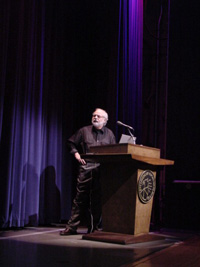 Victor
Vitanza's "Year Zero: Faciality":
Redux ...! is, as we've come to expect from him, an extravaganza, a
deep and playful contemplation of the exceptionally familiar (faces), in
a multimedia context that functions as a performance that should be witnessed
as well
as read. It is an example of how we might use multimedia to reinvigorate
theory with artistry, if not humor. It's not that theory has been without
either; it's just sometimes hard to notice that artistry when it's presented
to
us in
containers
(journal articles, printed books) that we've come to associate with seriousness
(which doesn't include playfulness, just wry humor now and then) and real
"work." VV has always battled against such tendencies,
even though, or so I would argue, his work is perhaps the most serious
of all. (Even play is serious business, scripted as it is in ideological
frameworks
that are all the more threatening because of their invisible control over
our natural inclinations.)
Victor
Vitanza's "Year Zero: Faciality":
Redux ...! is, as we've come to expect from him, an extravaganza, a
deep and playful contemplation of the exceptionally familiar (faces), in
a multimedia context that functions as a performance that should be witnessed
as well
as read. It is an example of how we might use multimedia to reinvigorate
theory with artistry, if not humor. It's not that theory has been without
either; it's just sometimes hard to notice that artistry when it's presented
to
us in
containers
(journal articles, printed books) that we've come to associate with seriousness
(which doesn't include playfulness, just wry humor now and then) and real
"work." VV has always battled against such tendencies,
even though, or so I would argue, his work is perhaps the most serious
of all. (Even play is serious business, scripted as it is in ideological
frameworks
that are all the more threatening because of their invisible control over
our natural inclinations.)
I
am fascinated by plasma balls, practically and metaphorically. 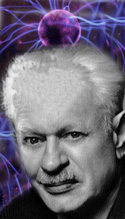 Plasma
balls are those lights you find in places like Spencer's Gifts and
that remind you of something you'd see in Dr. Frankenstein's laboratory.
They radiate bolts of electricity in random patterns until you touch
the
surface of the glass ball, at which time a steady bolt, sensing your
finger, jumps at you, leaving you tingling ever-so slightly. They are
fascinating
to watch and interact with in their own right. However, they suggest
something deeper to me, and so I have experimented in Photoshop to
try to capture that feeling. My first go at it was a work I call
(oh-so-imaginatively), "Plasma Ball Kenneth Burke." For this CoverWeb,
and given the circumstances, I feel the urge to reveal where I first
discovered this plasma-ball effect: in photographs from C&W 2003. Using
some
KPT
filters
to draw out the palpable charge emanating from the stage that day at
C&W
2003
when
Vitanza
performed
(see image above), I have captured the plasma-ball effect on Vitanza.
Although not visible to the naked eye at the time except in brief, strobe-like
flashes,
these
radiations
have
been
rendered here. In this sequence of images, I
zoom in closer as VV's presentation drew to a close so that you can
see the electracy he had unleashed:
Plasma
balls are those lights you find in places like Spencer's Gifts and
that remind you of something you'd see in Dr. Frankenstein's laboratory.
They radiate bolts of electricity in random patterns until you touch
the
surface of the glass ball, at which time a steady bolt, sensing your
finger, jumps at you, leaving you tingling ever-so slightly. They are
fascinating
to watch and interact with in their own right. However, they suggest
something deeper to me, and so I have experimented in Photoshop to
try to capture that feeling. My first go at it was a work I call
(oh-so-imaginatively), "Plasma Ball Kenneth Burke." For this CoverWeb,
and given the circumstances, I feel the urge to reveal where I first
discovered this plasma-ball effect: in photographs from C&W 2003. Using
some
KPT
filters
to draw out the palpable charge emanating from the stage that day at
C&W
2003
when
Vitanza
performed
(see image above), I have captured the plasma-ball effect on Vitanza.
Although not visible to the naked eye at the time except in brief, strobe-like
flashes,
these
radiations
have
been
rendered here. In this sequence of images, I
zoom in closer as VV's presentation drew to a close so that you can
see the electracy he had unleashed:
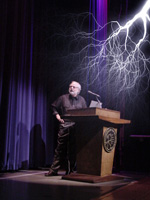 |
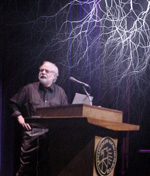 |
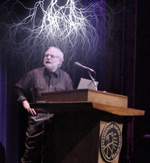 |
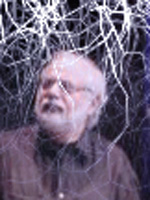 Well
into the performance I noticed the distinct resemblance to the plasma-ball
effect, captured in this last image. What I found striking about this
sequence of images flashed at me quickly. In digitizing the real, we
uncover its dimensionality. We often talk about such layers of the
real being "out there," -- somewhere out there in the twilight zone. But
clearly,
there was a happening in the hardscape of the real that day, as
indicated in these photographs. We miss so much of what passes before
our eyes and ears that it's a wonder we see at all, or can manage to see
anything but selectively. Our world is not so much shrouded, but filtered
(insidiously or innocently) at every moment of our waking lives--in
and through language and the perceptual transformation of
experience. But if we work hard we can discover digital dimensions
in the familiar--in faces, on stage, on screen--and thereby learn that
the hardscape is perhaps not so hard or singular as we might experience
it. Ideas are like tendrils or feelers. They touch other ideas and
draw
the
attention.
It takes great skill to direct this energy in anything but random patterns
and to multiply possibilities for acting.
Well
into the performance I noticed the distinct resemblance to the plasma-ball
effect, captured in this last image. What I found striking about this
sequence of images flashed at me quickly. In digitizing the real, we
uncover its dimensionality. We often talk about such layers of the
real being "out there," -- somewhere out there in the twilight zone. But
clearly,
there was a happening in the hardscape of the real that day, as
indicated in these photographs. We miss so much of what passes before
our eyes and ears that it's a wonder we see at all, or can manage to see
anything but selectively. Our world is not so much shrouded, but filtered
(insidiously or innocently) at every moment of our waking lives--in
and through language and the perceptual transformation of
experience. But if we work hard we can discover digital dimensions
in the familiar--in faces, on stage, on screen--and thereby learn that
the hardscape is perhaps not so hard or singular as we might experience
it. Ideas are like tendrils or feelers. They touch other ideas and
draw
the
attention.
It takes great skill to direct this energy in anything but random patterns
and to multiply possibilities for acting.